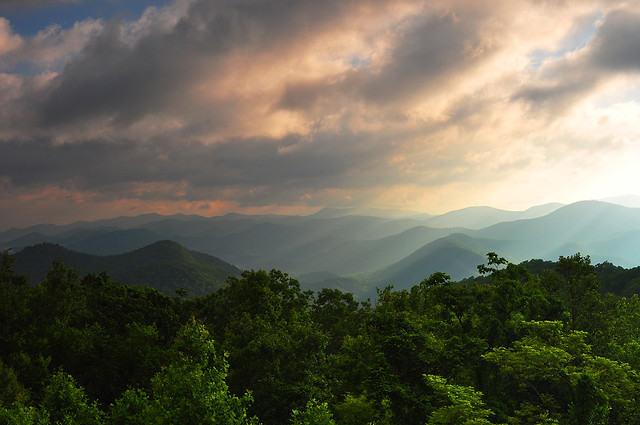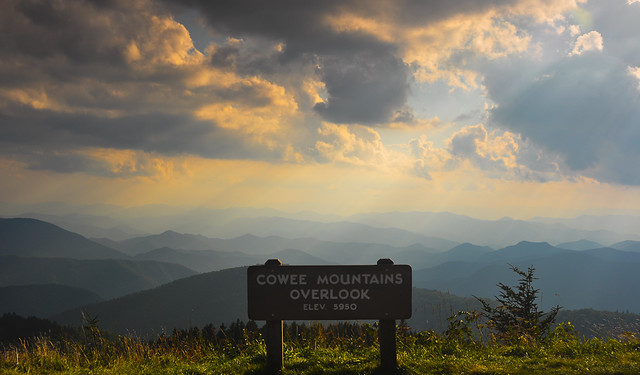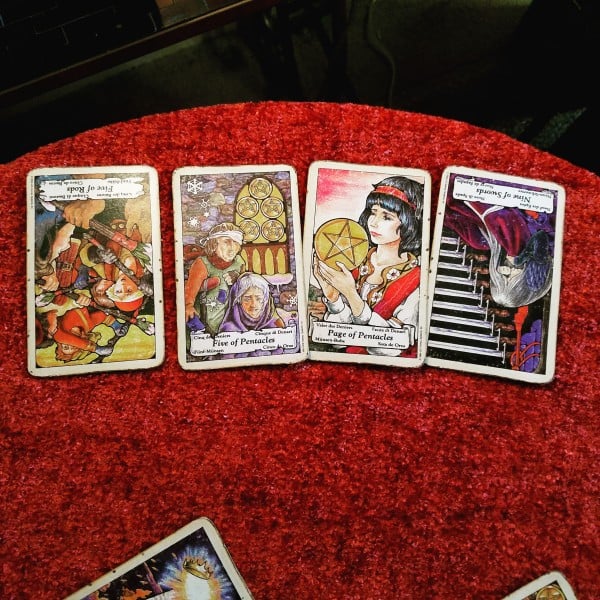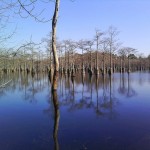
I was born and raised, as the phrase goes, in the desultory tail end of the Appalachian mountain chain as it swings through north Georgia on its way to Alabama, and the twangy lilt of Appalachia persists in my voice through graduate school and nearly thirty years down from the mountains. Since I reached adulthood, I have lived both in the rolling Piedmont and in the sandy-soiled, pine and palmetto strewn coastal plains, and spent most of my time in and around the buzzing, sprawling, urban tangle of Atlanta. I’ve learned to love all of the places I’ve lived, sometimes with a bit of negotiation and difficulty. But some part of my heart is full of a wild yonder, smoke-blue mountains rising to hazy blue distance. I was a fleet feral barefoot child there, and a serious-minded poetic young girl. Even when nobody else in the world understood me, the wind in the pine trees and the ancient worn-down ridges and peaks held serene. Whenever I go home to visit family, as soon as I can see those mountains, my heart lifts.
The Elk River is poisoned. You may have heard. It may seem far away, but rivers are long, and connect to other rivers. The Elk flows into the Kanawha, which flows into the Ohio, which flows into the Mississippi, which flows into the Gulf…which has had more than enough crap dumped into it already.

There is magic there, in those mountains. Inherent in the woods and hollows, tumbling down the mountain sides, rising up like mist, but also in the people: their songs and stories and ways, their yarbs and praying rocks, their burn-talking, water-dowsing, blood-stopping charms. Things get remembered there that other people forget, until one day somebody wonders where that Child ballad or old-timey cure went and comes looking to find it, kept safe in the memory of the mountain and its folk. It is not a coincidence that Faery, the most well-known “home grown American strain of religious witchcraft” as Ronald Hutton called it, has its roots in Appalachia. If you have any love of such things, know that the tributaries of your knowledge have springheads in those hills.
The magic cannot be separated from the land. You can put the knowledge in a book, perhaps, but that does not preserve it; once everything is gone but the dry pages, they only point to what is lost. Magic is alive, as the mountains are alive, as we are alive. One of the most diverse ecosystems on Earth cloaks those mountains like a mantle woven from a million colors. Richness, true wealth, in the living breathing threads, wealth we barely comprehend because it seems so ordinary, precious beyond anything else we know or could tell. Like the old ballads, we remain ignorant of its value, perhaps, until it is lost…except when a thing is finally gone from these mountains, the oldest in the world, it is gone forever.
The truth is, this latest calamity isn’t new. It hasn’t been new in my lifetime…or in the last century. That glory has been being slowly poisoned to death all this time. In Night Comes to the Cumberlands, Harry Caudill chronicles the pattern of destruction and exploitation carried out all over the region: First the trees, then the coal. Starting in the late nineteenth century, the dense forests were razed; then, when mineral wealth was discovered under the now denuded ground, coal companies secured deeds to mineral rights with contracts that would cause Mephistopheles to blush with envy:
The broad-form deeds passed to the coal companies title to all coal, oil, and gas, and all “mineral and metallic substances and all combinations of the same.” They authorized the grantees to excavate for the minerals, to build roads and structures on the land and to use the surface for any purpose “convenient or necessary” to the company and its successors in title. Their wordy covenants passed to the coal men the right to use as mining props the timber growing on the land, to divert and pollute the water and to cover the surface with toxic mining refuse. The landowner’s estate was made perpetually “servient” to the superior or “dominant” rights of the owner of the minerals. And, for good measure, a final clause absolved the mining company from all liability to the landowner for such damages as might be caused “directly or indirectly” by mining operations on his land.
…a single acre sometimes yielded fifteen or twenty thousand tons [of coal]….For this vast mineral wealth the mountaineer in most instances received a single half-dollar.
It is evident that the modern descendents of yesteryear’s coal men view this period as a golden age, a time when they could plunder freely without any pesky environmental or safety regulations or indeed any legal restraints whatsoever. They are anxious for those days to return. The usual defense is to explain at length how they have brought in jobs and industry; the benefits of their reign can be seen in that a hundred and twenty years later, after many many billions of dollars of mineral wealth have been extracted from the region, how well the descendants of those original landowners are doing. Hardly an Appalachian child goes hungry, and poverty is a thing of the past. Oh, wait…
How can this be? How can the rest of America sit by complacently and watch this unfold, with barely a flicker of outrage? Well, part of the reason is that we have been carefully taught that Appalachia is a worthless backwater, full of ignorant, racist, inbred, willfully impoverished, disposable people who aren’t worth listening to and can’t be saved.
Understand that this is a lie. Understand that it is a lie that has legs because it serves the interests, not only of the rich and powerful, but of every person who benefits from cheap coal and natural gas. This means you. If you live in the service area of a coal-burning plant…and you probably do…understand that people who look and sound like me die to keep your lights on. You are complicit, but so am I. We live in a world that shapes our choices, and only through a collective rebellion can we change that reality in a way that will do some good. That’s why politics, rather than personal moral choice, is the answer to certain kinds of systemic problems.
But the hillbilly stereotype, like other kinds of prejudice, serves other motives as well. It is classism, pure and simple, as well as the kind of cultural prejudice which is next door to racism, and like other “isms” serves a twofold purpose: It punishes the exploited, disheartens them to keep them down and saps their will to fight, and it divides them from their potential allies. It gives those who might otherwise feel some solidarity or a modicum of guilt the ability to rationalize that “those people” deserve what they get. Like Eric Waggoner and Zada Mae and Betsy Phillips and Byron Ballard, I have less patience with that:
“this country has a long history of believing every terrible thing it hears about Appalachia…” — “The Hillbilly Backlash” Betsy Phillips
“To hell with everyone who ever asked me how I could stand to live in a place like this, so dirty and unhealthy and uneducated. To hell with everyone who ever asked me why people don’t just leave, don’t just quit (and go to one of the other thousand jobs I suppose you imagine are widely available here), like it never occurred to us, like if only we dumb hilljacks would listen as you explained the safety hazards, we’d all suddenly recognize something that hadn’t been on our radar until now.”
– “I’m From West Virginia and I’ve Got Something to Say About the Chemical Spill” Eric Waggoner
“The same progressives and liberals who would have us believe they care for the underprivileged and oppressed also like to point at the working class white people in WVA and use words like ‘redneck’ and ‘snuff dippers’ and ‘hillbilly’ to describe them.
Enough. Enough.”
– “But what am I to do with all this fury, all this rage?” Byron Ballard

Do you think the beauty of the mountains is somehow in ironic contrast to the ugliness and squalor of its human inhabitants, that they just somehow wound up there by happenstance and are as insensible to the complex living world around them as so many bumps on a log from a old-growth tree? Or are you willing to contemplate the idea that they are the descendents of people who chose to live in all that beauty despite the difficulty of making a living there, and that that could say something about who they are? that their enthusiastic preservation of oral storytelling and old ballads and music and arts of all kinds indicates a love of such things for their own sake? that their ingenuity and ability (not yet entirely lost) to make anything out of two sticks, a rock, and a piece of home-made string, or to cure sickness with weeds out of the yard, are due to an intimate knowledge of the environment which might be useful somehow? that you have been sold a bill of goods, about the region, about the people, about us?
I am not trying to romanticize the people of Appalachia, either; that’s just another trap. I am just saying that one of the answers to “If things are so bad there, why don’t you just move?” is “Because we love these mountains.” Another is, “To where?” This is not just a story about Appalachia, you understand. This is a story about everywhere.

To contribute to relief efforts aimed at some of the hardest hit, go here.
















